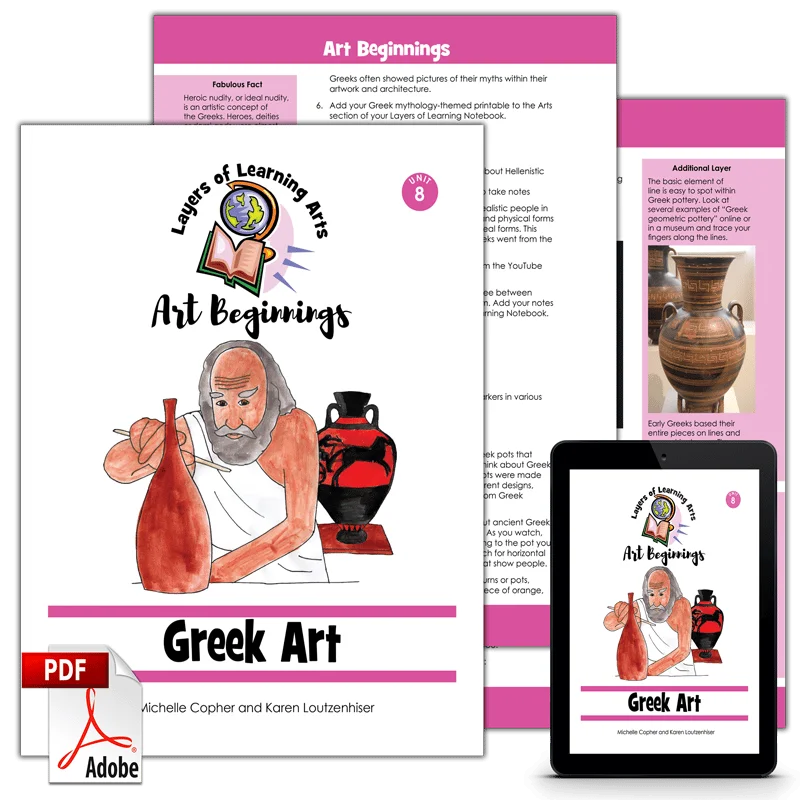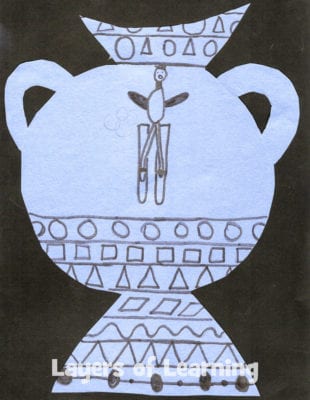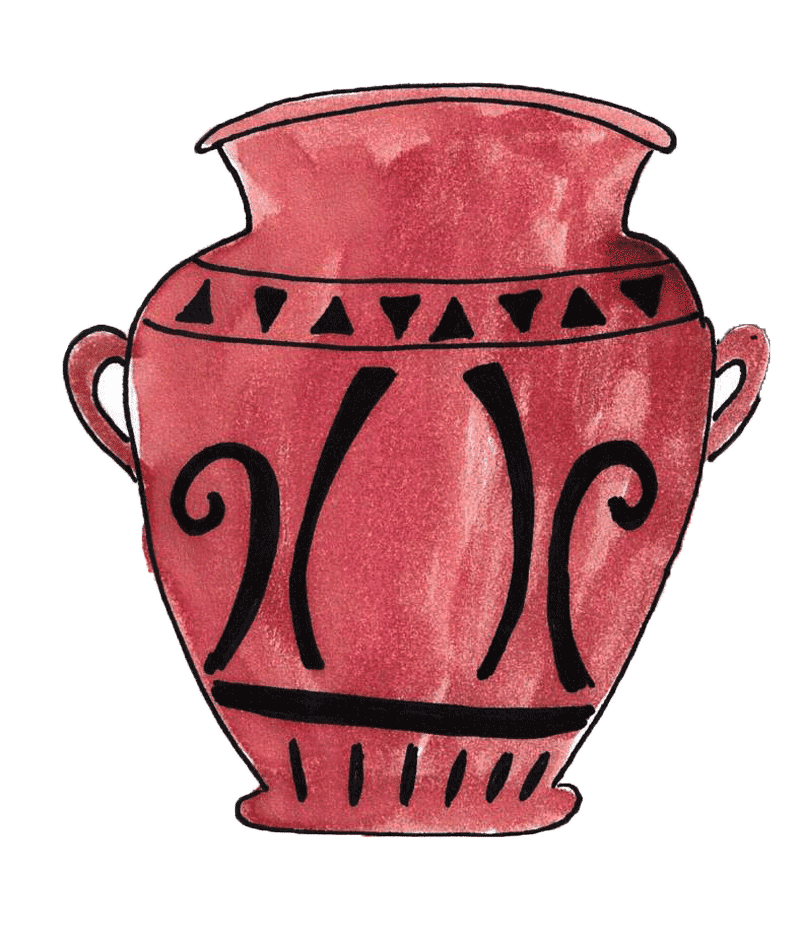This exploration is for all ages, as the colored smilies show. You can do the Grecian Urns art project with your whole family together!




The Grecian Urns art project is from Greek Art. Layers of Learning has hands-on projects, experiments, and printables in every unit of this family-friendly curriculum. Learn more about Layers of Learning.
The ancient Greeks were advanced for their time. They had fully functioning cities with far more conveniences than you would expect for an ancient civilization. Many civilizations spend the majority of their time consumed with just providing for their basic needs – food, water, shelter, and safety. When a civilization begins to really flourish, they grow beyond those basic needs and begin to focus on beauty, art, and decor. The Greeks achieved this, flourishing beyond necessity into beauty. Their architecture, art, and even everyday items were not only functional but beautiful and reflective of their values. We have been enjoying their exquisite designs ever since.
Grecian urns were pieces of art that were useful as well as beautiful. Urns were very common in ancient Greece as they were used to store food, water, and wine in. Urns also held things like cosmetics, perfumes, and spices, or were used to transport things in. Any old pot would serve these functions. If you think about it, we use plastic pitchers, Tupperware, and cloth or plastic cosmetic pouches. We rarely use anything as fancy as an urn for these purposes. But the Greeks weren’t just holding things; they were making beautiful works of art that were also useful. They incorporated geometric lines and designs and often had a scene of importance center stage on the urn as well. The scenes on the urns often told stories or showed important people or events.

By Tilemahos Efthimiadis from Athens, Greece [CC-BY-2.0 (http://creativecommons.org/licenses/by/2.0)], via Wikimedia Commons
Step 1: Library Research
Before you begin exploring, read a book or two about Greek art. Here are some suggestions, but if you can’t find these, look for books at your library about ancient Greece, Greek art, Greek pottery, or Greek mythology (many of the urns showed scenes from Greek myths). The colored smilies above each book tell you what age level they’re recommended for.
As Amazon affiliates, the recommended books and products below kick back a tiny percentage of your purchase to us. It doesn’t affect your cost and it helps us run our website. We thank you!

D’Aulaires’ Book of Greek Myths
by Ingri & Edgar D’Aulaire
Step 2: Grecian Urn
You’ll need construction paper, scissors, black markers, and glue.
- After looking at several ancient Greek urns, sketch your own urn design on a piece of colorful construction paper.
- Cut out the outline and glue it on to a darker piece of construction paper.
- Use a ruler to draw straight lines across the urn at varying intervals. Leave a larger space in the center where a scene will go. Within each of the narrow intervals, add geometric shapes or patterns to fill in the spaces. The Greeks valued this kind of order, pattern, and unity within art.
- Within the larger space, draw something you value. It can be a scene from an important story in your life, an item that is important to you, or a favorite memory. The geometry, order, and patterns, along with the basic form, are representative of the Greeks, but the focal point of the urn is representative of the artist. It should be something that reflects who you are. The Greeks valued their stories and myths, so often those were the subject of their scenes, but you are going to depict something you value on your urn.
- You can consider your project complete, or you can go on and paint your design on an actual piece of pottery.

If you like the paper Grecian urn art project and want to try a more advanced version get a plain terra cotta urn and some black acrylic paint.
Start by sketching your design on the pot with pencil, then paint the background black, leaving the figures terra cotta.

For older teens only: Ode on a Grecian Urn

For older students, Keats’ Ode on a Grecian Urn is a fascinating and detailed poem that looks at one particular piece of artwork that Keats examined at length – a Greek urn that had various scenes painted on it.
Keats was not Greek and was not alive during ancient times. He was an English Romantic poet. However, in his poem, he imagined and played out the stories he saw pictured on an ancient Greek urn. He wrote about the scenes he saw and expounded on the themes of the permanence of art versus mortality, happiness and youth, and the nature of truth and beauty. It is a close examination of art. Read and discuss the poem.
Discussion Questions
- How does Keats compare perfection with imperfection?
- Youth, lovers, and musicians are all depicted on the urn. What do you think those pictures represent?
- Is art immortal? What does Keats believe about this? Do you agree or disagree?
- What two metaphors for the urn can you spot in the second stanza?
- The urn is cold, still, and silent. The scenes depicted on it are full of warmth, life, and music. What point do you think Keats was trying to make by this contrast?
- Is beauty truth? Is truth beauty?
Step 3: Show What You Know
Show off your Grecian urn to an audience. As you do, explain your art project in terms of some of the elements and principles of art – line, shape, color, pattern, and balance. How did you use each of those within your piece? Also, describe the scene you added and what importance it has to you. if you chose to make a paper version as well as paint an actual pot, show both of your versions and explain any changes you made on the final version.
Additional Layers
Additional Layers are extra activities you can do or tangents you can take off on. You will find them in the sidebars of each Layers of Learning unit. They are optional, so just choose what interests you.
Writer’s Workshop
Read several Greek myths and then rewrite one you enjoy in your own words. Illustrate your version of the myth too.

Greek art often featured their stories, so as you look at their art, spot the characters from their stories. You can also use a scene from one of the myths on your pottery art if it meant something important to you.
Expedition
Contact someone with a pottery wheel in your town (often universities or private pottery shops offer classes or workshops) and learn to throw pots. You’ll have a whole new appreciation for just how difficult an art this really is.

Additional Layer
Sculpt two basic pots or bowls out of clay. On one, use a toothpick to carve out your design. Leave the other pot smooth. Bake both pots to harden them. Once they are dry and cool, paint the pot that was left smooth. These were the two styles of decoration the Greeks used – carving (or inscription) and painting.
Get a Free Unit
Choose between the first unit in each Layers of Learning subject to try for free when you sign up for the newsletter.
We never spam and you can cancel your subscription at any time.











cool
Fabulous idea! And here’s some insight to go with it:
Yeats Poem, Ode on a Grecian Urn, or at least it’s final line…
“Beauty is truth, truth beauty,—that is all
Ye know on earth, and all ye need to know.”
…seems to really irritate some people. (Who react with speedy logic: “The pure gall of the man to write such a ridiculous thing! I mean just look at all the ugly truth in this world!”)
However (here is an overarching thought to consider), since the predominant philosopher for all of the Romantics, from Blake to Yeats, was Plato, the culminating line of Yeats famous poem makes beautiful sense. Because, you see, Plato believed that the eternal verities (or principles) such as the ideals of Beauty, Goodness, and truth were not of this world — but rather of a timeless, spaceless realm of pure ideas.